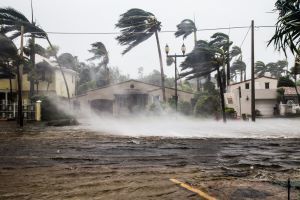
It’s that time of year again, and hurricane season is rapidly encroaching with a start date of June 1 in the Atlantic and May 15 in the Pacific. During this time, you may make it a part of your daily routine to check in on the weather every morning to stay ahead of potential inclement weather. If you live on the coast, you may have even thought about where you and your family can stay if severe weather does hit.
As climate change worsens, so are the storm surges we will be experiencing. In fact, experts at Colorado State University predict an above normal 2022 hurricane season, with activity projected at 130% of the average year. This means that hurricanes are now starting to not only affect the coast, but could travel as far inland as 200 miles, so no matter where you live, it’s better to be safe than sorry. Wellhart presents some important hurricane prep steps you can take to stay safe for the 2022 hurricane season:
1. Make a Plan
In the event of a major storm, you and your family may need to evacuate your home. It’s a plus if you have family or friends to stay with to weather the storm, but if needed, take note of nearby shelters and different routes to get there.
For pet owners, local animal shelters may be able to offer advice on what to do with your pet in the event of an evacuation, but it’s best to identify family, friends, pet-friendly hotels, or shelters where your pet can stay beforehand.
2. Get Your Loved Ones Ready
Always be sure that you go over your plan with your family so they know what to expect. Make sure that everyone has emergency numbers saved in their cell phone and that they know what to grab and where to gather before you evacuate.
If you or a loved one is older or disabled and will not be able to move quickly, call the hospital, public health department, or the police about special needs for advice on how to prepare.
Lastly, keep yourself and your loved ones updated about the weather reports, and most importantly, know the difference between a hurricane watch and warning. According to the CDC:
- A hurricane watch means hurricane conditions (sustained winds of 74 miles per hour [mph] or higher) are possible in a stated area. Experts announce hurricane watches 48 hours before they expect tropical-storm-force winds (sustained winds of 39 to 73 mph) to start.
- A hurricane warning is more serious. It means hurricane-force winds are expected in a stated area. Experts issue these warnings 36 hours before tropical-storm-force winds are expected in the area to give people enough time to prepare for the storm.
3. Pack an Evacuation Kit
If you’re forced to evacuate, chances are you won’t have time to track down and pack all of your important documents to avoid them getting damaged. Pack important documents, sentimental items, and anything essential that you cannot leave behind ahead of time.
Furthermore, it’s likely that emergency supplies will be hard to come by if there is an evacuation order in your area. Even if you aren’t forced to evacuate, a hurricane could still cut off your power and water supply. To keep yourself and your family safe, be sure to prepare the following essentials:
- An emergency supply of non-perishable food and water
- An emergency medicine and first aid supply
- Power sources such as flashlights with extra batteries
- A fire extinguisher with instructions on how to use it
4. Get Your Transport Ready
If and when a severe hurricane hits, an evacuation plan is no good without a form of transportation. If you have a car, make sure the gas tank is always full, it’s packed with your emergency kits, and that it’s kept in your garage or under some type of cover to avoid damage from things like falling tree branches.
If you don’t have your own car, be sure to make arrangements with a friend or family member. In the worst case scenario, in the case of evacuation, you can always call authorities to get a ride. Just be sure that you have emergency numbers saved in your phone ahead of time.
5. Prepare Your Home
From tree branches to bicycles, there are lots of items that could blow around in high winds and cause property damage if left unchecked in a natural disaster. Move any of these items including lawn furniture, grills, propane tanks, and building materials into your basement or garage, and be sure to have any large tree branches trimmed and removed.
In the case that you missed something or perhaps a neighbor’s property blows over, it also doesn’t hurt to use storm shutters or even board up windows and doors with plywood and nails to prevent shattered glass.
Lastly, stay prepared by reviewing your insurance policies to make sure that if you’ll need to repair or rebuild your home, or have your belongings replaced, that you’re covered. Many home and business insurance policies do not cover flooding, so be sure to look into adding flood insurance to your policy if you don’t already have it.
It’s important to always stay prepared to protect yourself, your family, and your property. What you do to prepare today could save you, your home, or your business tomorrow.
If you are a healthcare provider who is interested in assisting in natural disaster relief, fill out our contact form to get in touch.
